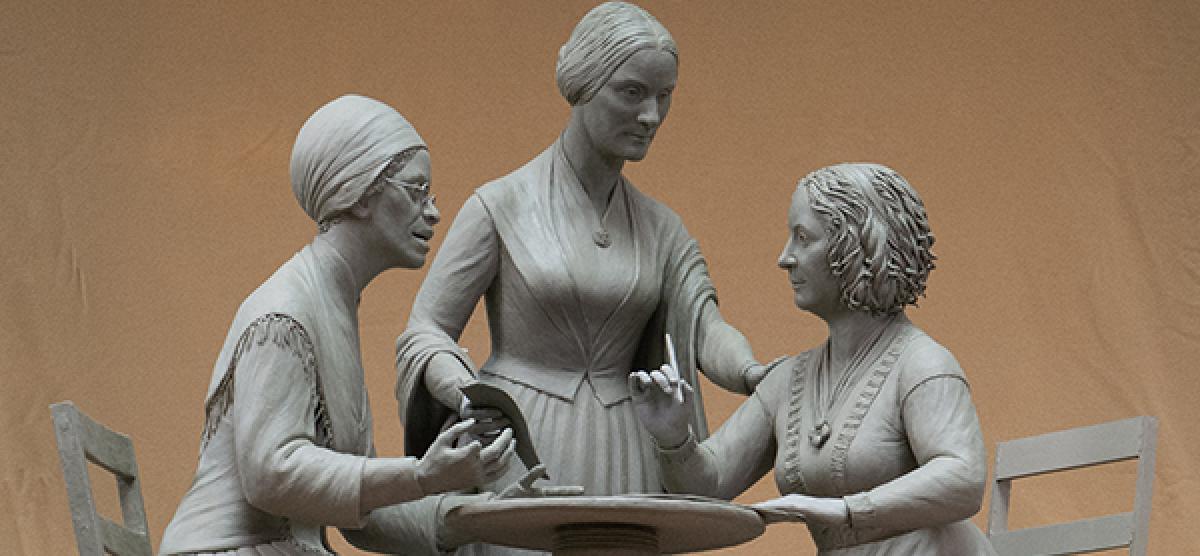
Namita Luthra '91 on the Central Park Women's Suffrage Statue
To mark the 100th anniversary of the ratification of the 19th Amendment, Monumental Women is unveiling a new statue honoring women’s rights pioneers Sojourner Truth, Susan B. Anthony, and Elizabeth Cady Stanton in New York's Central Park. Below, Namita Luthra ’91, who sits on the Monumental Women board, talks about the project, its significance, and more.
How did the Monumental Women project come about?
Seven years ago, several New Yorkers noticed that among the statues in Central Park not one was of a woman. Alice in Wonderland? Sure. But no real women. They decided to form a 501(c)(3) nonprofit to get a monument built to honor the women who began the fight for the vote. From the beginning, the mission had three parts: “break the bronze ceiling” in Central Park, challenge other municipalities to honor women and people of color in their public spaces, and create a women’s history education campaign.
Every year—except during a global health pandemic—42 million people visit Central Park and they deserve to see tributes to real women, the ones who gave their lives to expanding our definition of “We the People.” The Women’s Rights Pioneers Monument honoring Sojourner Truth, Susan B. Anthony, and Elizabeth Cady Stanton is a fitting start.
How did you get involved?
I first learned of Monumental Women through newspaper reports of Girl Scouts raising money and awareness for the monument. My daughter is a Girl Scout, and in 2017 I presented the idea to her troop. This was a group of wonderful, intelligent fourth graders, many of whom had grown up playing in Central Park. I’ll never forget the moment I asked them if they’d ever noticed that the park had no statues of women. “Wait, not a single one?” they asked incredulously. “How can that be?” Ideas flew around the circle about what they could do and how they could help. They decided to donate their cookie sale money to the building of the statue. That year, they raised $2,000, double their original goal, and presented all of it to Monumental Women. They also wrote letters to U.S. Senator Kirsten Gillibrand explaining why a statue mattered to them.
She wrote back right away, saying, in part: “Dear Girl Scout Troop 3482, thank you for writing to me with your concerns about the gender imbalance of statues in Central Park. I am very impressed with your hard work and activism... I commend all of you for raising your voices together. I will never stop fighting for what is right, and I am glad that Troop 3482 is fighting, too.”
How did the project unfold?
There was a design competition where sculptors from around the country submitted proposals. From more than a hundred submissions, a nine-member jury chose Meredith Bergmann’s design. The original design featured Anthony, Stanton, and a long scroll etched with quotations of diverse suffragists all leading to a ballot box. When the City’s Public Design Commission unanimously approved the monument but said that the scroll and ballot box had to go, we knew we had to include the diversity of women in a different way. It was decided that Sojourner Truth, an abolitionist, women’s rights advocate, and another New York woman, would take her rightful place at the table. In September 2019, I, along with other Monumental Women board members, and Ms. Bergmann testified at City Hall in favor of the new design. One month later the Public Design Commission approved it.
We raised more than $1.5 million dollars, and none of that could have happened without the early and vital support of New York Life. We have also received unwavering support from the Manhattan Borough President Gale Brewer, Councilwoman Helen Rosenthal, and more than 1,000 individual donations.
The monument is being installed on Literary Walk, a prominent location in Central Park. There were bureaucratic hurdles along the way, but at long last it is taking its place in the park on the 100th anniversary of the 19th Amendment’s ratification. It will stand 14 feet tall and weigh around 73,000 pounds (36 tons). Last fall when I saw the work in progress in the sculptor’s Connecticut studio I was awed by the size but even more moved by the small details: Truth’s hand and Anthony’s alligator-skin bag bursting with papers including a petition for universal suffrage.
What will happen at the unveiling?
The unveiling on Aug. 26 will be live-streamed starting at 7:45 a.m. EDT on monumentalwomen.org. It will be a historic day, celebrating three women’s rights pioneers: Sojourner Truth, Susan B. Anthony, and Elizabeth Cady Stanton—all New Yorkers. They sit, working around a table, each one representing a different arm of activism: speaking, writing, and as Anthony put it, “agitating.” Isn’t that the way so much of women’s work gets done, hatching ideas, reimagining the world, and then going out to make change?
When we unveil the monument we are asking everyone watching, no matter where they are in the world, to reimagine their public spaces in their towns and ask if they honor the important women who paved the way for generations to come.
Our monument will be both seen and heard with Viola Davis voicing Truth, Meryl Streep voicing Stanton, and Jane Alexander voicing Anthony. Three other extraordinary actors—America Ferrera, Rita Moreno, and Zoe Saldana—will voice the Spanish-language version. The rich timber and cadence of the actors’ voices only further helps bring history to life.
Is there a next step for Monumental Women?
Yes. This monument was always the start and never the end of our work. Helping municipalities across the country reimagine their public spaces and pay tribute to the women and people of color who helped make them was always a central aim. Launching a women’s rights education campaign to make history come alive will also begin in earnest.
Tell us about your career trajectory and Bryn Mawr’s influence on you.
Arriving at Bryn Mawr from a small steel-mill town in West Virginia was a dream. Being in a college with a statue of Athena felt like just the right place to be. I remember researching in Canaday Library and writing a paper about the interconnectedness of the abolition and suffrage movements. Recently I interviewed, in different settings, historians Ellen Dubois, Susan Ware, and Elaine Weiss, and realized that my understanding of the suffrage movement has deepened immensely. Life has come full circle from that first research paper until now.
My time as a litigator at the ACLU Women’s Rights Project, founded by Ruth Bader Ginsburg in 1972, was among the most rewarding of my career. Now, my work with Monumental Women pays homage to the past but keeps me laser-focused on the work towards full equality that lies ahead.
In less than 100 words, how would you persuade someone of this project’s significance?
When you excavate women’s history and learn the faces and voices of the fearless, tactical, and persistent women who came before and all they had to overcome, it feels like there’s no limit to what you can achieve. There’s a thread that ties their generation to ours and ours to the generations of girls and women still to come.
Published on: 08/19/2020
